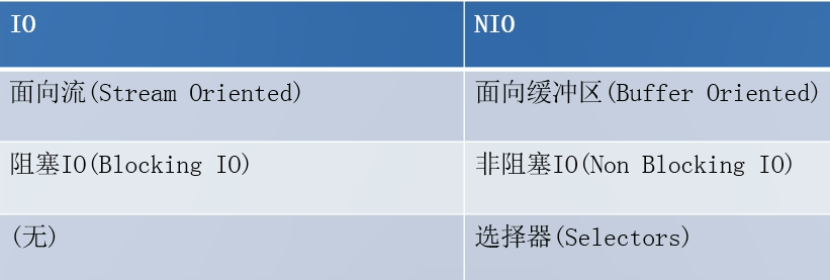java-nio
javanio可以替换传统的io,对于java 的nio理解,可以联想到io。但是他们也有不一样的地方。
1.传统io和nio区别:

2.Buffer 中的重要概念:
Ø 容量 (capacity) : 表示 Buffer 最大数据容量,缓冲区容量不能为负,并且创建后不能更改。 缓冲区其实就是数据组,因为是数组,所以数据容量一旦固定就不能修改了。
Ø 限制 (limit): 第一个不应该读取或写入的数据的索引,即位于 limit 后的数据不可读写。缓冲区的限制不能为负,并且不能大于其容量。
Ø 位置 (position): 下一个要读取或写入的数据的索引。缓冲区的位置不能为负,并且不能大于其限制
Ø 标记 (mark)与重置 (reset): 标记是一个索引,通过 Buffer 中的 mark() 方法指定 Buffer 中一个特定的 position,之后可以通过调用 reset() 方法恢复到这个 position。
标记、 位置、 限制、 容量遵守以下不变式: 0 <= mark <= position <= limit <= capacity
注意:mark初始化为-1,表示没有标记过
3.来段代码理解一下
package com.nio.nio; import java.nio.ByteBuffer; import org.junit.Test; /** * 一、缓冲区(Buffer):在java NIO中负责数据的存取。缓冲区就是数据。用于存储不同数据类型的数据 * * 跟局数据类型的不同(boolean除外,其他7种基本类型全有),提供相应类型的缓冲区: * ByteBuffer * CharBuffer * ShortBuffer * IntBuffer * LongBuffer * FloatBuffer * DoubleBuffer * * 上述缓冲区的管理方式几乎一致,通过allocate()获取缓冲区 * 最常用的是ByteBuffer,因为无论磁盘还是网络传输的都是Byte。 * * 有了缓冲区,接下来要往缓冲区存取数据 * * 二、缓冲区存取数据的两个核心方法: * put():存入数据到缓冲区中 * get():获取缓冲区中的数据 * * 要想对缓冲区的数据进行正确的存取的话,必须姚先了解几个缓冲区的核心属性 * * * 三、缓冲区中的四个核心属性: * capacity:容量,表示缓冲区中最大存储数据的容量。一旦声明不能改变。(因为缓冲区就是数组,数组大小不可改变) * limit:界限,表示缓冲区中可以操作数据的大小。(limit后面的数据不能进行读写) * position:位置,表示缓冲区正在操作数据的位置。 * * position <= limit <= capacity * * * mark:标记,表示记录当前position的位置。可以用过reset()恢复到mark的位置。 * * 0 <= mark <= position <= limit <= capacity * * mark初始化为-1,表示没有标记过 * * * @author HappyBks * */ public class TestBuffer { @Test public void test1(){ //1、分配一个是指定大小的缓冲区 ByteBuffer buf=ByteBuffer.allocate(1024);//指定缓冲区大小capacity为1024 printBufferStatus(buf, "allocate()"); //2、利用put()方法存入数据到缓冲区中 final String dataStr="abcde"; buf.put(dataStr.getBytes()); printBufferStatus(buf, "put()"); //3、切换读取数据模式 buf.flip(); printBufferStatus(buf, "flip()"); //4、利用get()读取缓冲区中的数据 byte[] dst=new byte[buf.limit()]; buf.get(dst); System.out.println(new String(dst, 0 , dst.length)); printBufferStatus(buf, "get()"); //5、调用rewind(),恢复读模式到读之前的初始状态,用于可重复再读一次 buf.rewind(); printBufferStatus(buf, "rewind()"); //6、clear()清空缓冲区,回到allocate()申请缓冲区的最初状态。 //但是请注意,这个恢复到最初状态,指定是buffer的几个核心属性恢复到最初状态, //里面的数据依然还在,只不过这些数据处于“被遗忘”状态。 //所谓被遗忘状态,是指buffer的几个指针都恢复到了初始位置,里面有几个数据,从哪读到哪,已经都不知道了。 buf.clear(); printBufferStatus(buf, "clear()"); //尝试读取被clear()清空之后的缓冲区,数据依然在。(因为clear之后,我们无法之后原来有几个数据,所以读一个) System.out.println("clear()之后试着get()一个byte: "+(char)buf.get()); } private void printBufferStatus(ByteBuffer buf, String info) { System.out.println("---------"+info+"----------"); System.out.println("position: "+buf.position()); System.out.println("limit: "+buf.limit()); System.out.println("capacity: "+buf.capacity()); System.out.println(); } @Test public void test2(){ final String dataStr="abcde"; ByteBuffer buf=ByteBuffer.allocate(1024); buf.put(dataStr.getBytes()); buf.flip(); byte[] dst=new byte[buf.limit()]; buf.get(dst, 0, 2); System.out.println("get(dst, 0, 2): "+new String(dst, 0, 2)); System.out.println("get(dst, 0, 2) position: "+buf.position()); //mark():标记 buf.mark(); System.out.println("mark() position: "+buf.position()); buf.get(dst, 2, 2); System.out.println("get(dst, 2, 2): "+new String(dst, 2, 2)); System.out.println("get(dst, 2, 2) position: "+buf.position()); //reset():恢复到mark的位置 buf.reset(); System.out.println("reset() position: "+buf.position()); //判断缓冲区中是否还有剩余数据 if(buf.hasRemaining()){ //获取缓冲区中农剩余的可以操作的数据量 System.out.println("buf.remaining(): "+buf.remaining()); } } }
第一个例子演示了NIO的Byte缓冲区(其他数据类型的缓冲区操作方式大同小异)申请、写入、切换读模式、读取、可重复读、清空几个基本操作的使用方法,以及在这每个操作阶段缓冲区几个核心属性capacity、limit、position的变化。
第二个例子演示了读取时,如何标记特定位置、之后重置回到改位置重新读取、以及判断读取是否还有剩余、获知还剩多少未读的方法,以及每个操作阶段缓冲区几个核心属性position的变化。
4.直接缓存区和非直接缓存区:
看下一章直接缓冲区和非直接缓冲区的区别
5.通道概念
6.选择器
7.网络nio
ackage com.nio.nio; import java.io.IOException; import java.net.InetSocketAddress; import java.nio.ByteBuffer; import java.nio.channels.FileChannel; import java.nio.channels.ServerSocketChannel; import java.nio.channels.SocketChannel; import java.nio.file.Paths; import java.nio.file.StandardOpenOption; import org.junit.Test; /** * * 一、使用NIO完成网络通信的三个核心: * 1. 通道(Channel):负责连接 * java.nio.channels.Channel * |-- SelectableChannel * |-- SocketChannel * |-- ServerSocketChannel * |-- DatagramChannel * * |-- Pipe.SinkChannel * |-- Pipe.SourceChannel * (注意:FileChannel不能使用非阻塞模式!!!选择其主要监控网络Channel) * * 2. 缓冲区(Buffer):负责数据的存取 * 3. 选择器(Selector):是SelectableChannel的多路复用器。用于监控SelectableChannel的IO状况 * * */ public class TestBlockingNIO { //客户端 @Test public void client() throws IOException{ //1、获取通道(open这种方法是jdk1.7之后才引入的) SocketChannel socketChannel = SocketChannel.open(new InetSocketAddress("127.0.0.1", 8888)); //2、分配指定大小的缓冲区 ByteBuffer buf=ByteBuffer.allocate(1024); //3、从本地读取文件,并发送到服务端 FileChannel inFileChannel=FileChannel.open(Paths.get("D:/Test/NIO/1.jpg"), StandardOpenOption.READ); while(inFileChannel.read(buf)!=-1){ buf.flip(); socketChannel.write(buf); buf.clear(); } //4、关闭通道 inFileChannel.close(); socketChannel.close(); } //服务端 @Test public void server() throws IOException{ //1、获取端口 ServerSocketChannel serverSocketChannel = ServerSocketChannel.open(); //2、绑定连接 serverSocketChannel.bind(new InetSocketAddress(8888)); //3、获取客户端连接的通道 SocketChannel socketChannel = serverSocketChannel.accept(); //4、接收客户端的数据,保存到本地。(提到本地,就要弄个FileChannel) FileChannel outFileChannel = FileChannel.open(Paths.get("D:/Test/NIO/2.jpg"), StandardOpenOption.WRITE,StandardOpenOption.CREATE); ByteBuffer buf=ByteBuffer.allocate(1024); while(socketChannel.read(buf)!=-1){ buf.flip(); outFileChannel.write(buf); buf.clear(); } socketChannel.close(); outFileChannel.close(); serverSocketChannel.close(); } }
package com.nio.nio; import java.io.IOException; import java.net.InetSocketAddress; import java.nio.ByteBuffer; import java.nio.channels.FileChannel; import java.nio.channels.ServerSocketChannel; import java.nio.channels.SocketChannel; import java.nio.file.Paths; import java.nio.file.StandardOpenOption; import org.junit.Test; /** * * 一、使用NIO完成网络通信的三个核心: * 1. 通道(Channel):负责连接 * java.nio.channels.Channel * |-- SelectableChannel * |-- SocketChannel * |-- ServerSocketChannel * |-- DatagramChannel * * |-- Pipe.SinkChannel * |-- Pipe.SourceChannel * (注意:FileChannel不能使用非阻塞模式!!!选择其主要监控网络Channel) * * 2. 缓冲区(Buffer):负责数据的存取 * 3. 选择器(Selector):是SelectableChannel的多路复用器。用于监控SelectableChannel的IO状况 * * */ public class TestBlockingNIO { //客户端 @Test public void client() throws IOException{ //1、获取通道(open这种方法是jdk1.7之后才引入的) SocketChannel socketChannel = SocketChannel.open(new InetSocketAddress("127.0.0.1", 8888)); //2、分配指定大小的缓冲区 ByteBuffer buf=ByteBuffer.allocate(1024); //3、从本地读取文件,并发送到服务端 FileChannel inFileChannel=FileChannel.open(Paths.get("D:/Test/NIO/1.jpg"), StandardOpenOption.READ); while(inFileChannel.read(buf)!=-1){ buf.flip(); socketChannel.write(buf); buf.clear(); } /* //在阻塞IO下,如果关闭socketChannel,那么服务端不知道客户端是否已经把所有数据发完,所以会一直阻塞。 socketChannel.shutdownOutput(); //另一种方法就是把这个线程切换成非阻塞模式 */ //接收服务端反馈 int len = 0; while((len = socketChannel.read(buf)) !=-1){ buf.flip(); System.out.println(new String(buf.array(),0,len)); } //4、关闭通道 inFileChannel.close(); socketChannel.close(); } //服务端 @Test public void server() throws IOException{ //1、获取端口 ServerSocketChannel serverSocketChannel = ServerSocketChannel.open(); //2、绑定连接 serverSocketChannel.bind(new InetSocketAddress(8888)); //3、获取客户端连接的通道 SocketChannel socketChannel = serverSocketChannel.accept(); //4、接收客户端的数据,保存到本地。(提到本地,就要弄个FileChannel) FileChannel outFileChannel = FileChannel.open(Paths.get("D:/Test/NIO/2.jpg"), StandardOpenOption.WRITE,StandardOpenOption.CREATE); ByteBuffer buf=ByteBuffer.allocate(1024); while(socketChannel.read(buf)!=-1){ buf.flip(); outFileChannel.write(buf); buf.clear(); } //发送反馈给客户端 buf.put("服务端接收数据成功!".getBytes()); buf.flip(); socketChannel.write(buf); socketChannel.close(); outFileChannel.close(); serverSocketChannel.close(); } }
public class TestBlockingNIO { //客户端 @Test public void client() throws IOException{ //1、获取通道(open这种方法是jdk1.7之后才引入的) SocketChannel socketChannel = SocketChannel.open(new InetSocketAddress("127.0.0.1", 8888)); //2、分配指定大小的缓冲区 ByteBuffer buf=ByteBuffer.allocate(1024); //3、从本地读取文件,并发送到服务端 FileChannel inFileChannel=FileChannel.open(Paths.get("D:/Test/NIO/1.jpg"), StandardOpenOption.READ); while(inFileChannel.read(buf)!=-1){ buf.flip(); socketChannel.write(buf); buf.clear(); } //在阻塞IO下,如果关闭socketChannel,那么服务端不知道客户端是否已经把所有数据发完,所以会一直阻塞。 socketChannel.shutdownOutput(); //另一种方法就是把这个线程切换成非阻塞模式 //接收服务端反馈 int len = 0; while((len = socketChannel.read(buf)) !=-1){ buf.flip(); System.out.println(new String(buf.array(),0,len)); } //4、关闭通道 inFileChannel.close(); socketChannel.close(); } //服务端 @Test public void server() throws IOException{ //1、获取端口 ServerSocketChannel serverSocketChannel = ServerSocketChannel.open(); //2、绑定连接 serverSocketChannel.bind(new InetSocketAddress(8888)); //3、获取客户端连接的通道 SocketChannel socketChannel = serverSocketChannel.accept(); //4、接收客户端的数据,保存到本地。(提到本地,就要弄个FileChannel) FileChannel outFileChannel = FileChannel.open(Paths.get("D:/Test/NIO/2.jpg"), StandardOpenOption.WRITE,StandardOpenOption.CREATE); ByteBuffer buf=ByteBuffer.allocate(1024); while(socketChannel.read(buf)!=-1){ buf.flip(); outFileChannel.write(buf); buf.clear(); } //发送反馈给客户端 buf.put("服务端接收数据成功!".getBytes()); buf.flip(); socketChannel.write(buf); socketChannel.close(); outFileChannel.close(); serverSocketChannel.close(); } }
package com.nio.nio; import java.io.IOException; import java.net.InetSocketAddress; import java.nio.ByteBuffer; import java.nio.channels.SelectionKey; import java.nio.channels.Selector; import java.nio.channels.ServerSocketChannel; import java.nio.channels.SocketChannel; import java.util.Date; import java.util.Iterator; import org.junit.Test; public class TestNonBlockingNIO { //客户端 @Test public void client() throws IOException{ //1、获取通道 SocketChannel socketChannel = SocketChannel.open(new InetSocketAddress("127.0.0.1",8888)); //2、切换非阻塞模式 socketChannel.configureBlocking(false); //3、分配指定大小的缓冲区 ByteBuffer buf=ByteBuffer.allocate(1024); //4、发送数据服务器 buf.put(new Date().toString().getBytes()); buf.flip(); socketChannel.write(buf); buf.clear(); //5、关闭通道 socketChannel.close(); } //服务端 @Test public void server() throws IOException{ //1、获取通道 ServerSocketChannel serverSocketChannel = ServerSocketChannel.open(); //2、切换非阻塞模式 serverSocketChannel.configureBlocking(false); //3、绑定连接 serverSocketChannel.bind(new InetSocketAddress(8888)); //4、获取选择器 Selector selector = Selector.open(); //5、将通道注册到选择器上(第二个选项参数叫做选择键,用于告诉选择器需要监控这个通道的什么状态或者说什么事件(读、写、连接、接受)) //选择键是整型值,如果需要监控该通道的多个状态或事件,可以将多个选择键用位运算符“或”“|”来连接 //这里服务端首先要监听客户端的接受状态 serverSocketChannel.register(selector, SelectionKey.OP_ACCEPT); //6、轮询式地获取选择器上已经“准备就绪”的事件 while(selector.select() > 0){ //7、获取当前选择中所有注册的“选择键(已就绪的监听事件)” Iterator<SelectionKey> iterator = selector.selectedKeys().iterator(); while(iterator.hasNext()){ //8、获取准备“就绪”的是事件 SelectionKey sk=iterator.next(); //9、判断是什么事件准备就绪 if(sk.isAcceptable()){ //10、若接受就绪,获取客户端连接 SocketChannel socketChannel = serverSocketChannel.accept(); //11、客户端连接socketChannel也需要切换非阻塞模式 socketChannel.configureBlocking(false); //12、将该通道注册到选择器上,监控客户端socketChannel的读就绪事件 socketChannel.register(selector, SelectionKey.OP_READ); } else if(sk.isReadable()){ //13、获取当前选择器上“读就绪”状态的通道 SocketChannel socketChannel = (SocketChannel) sk.channel(); //14、读取数据 ByteBuffer buf=ByteBuffer.allocate(1024); int len=0; while((len=socketChannel.read(buf))>0){ buf.flip(); System.out.println(new String(buf.array(),0,len)); buf.clear(); } } //15、取消选择键SelectionKey iterator.remove(); } } } }
8.udpnoi
9.管道



